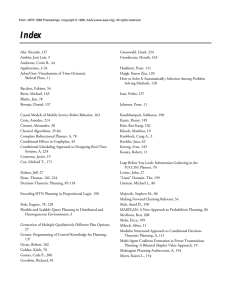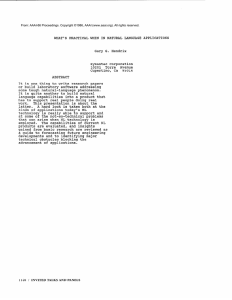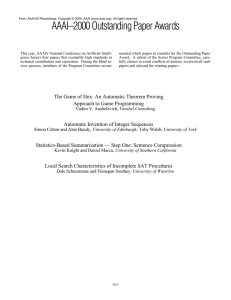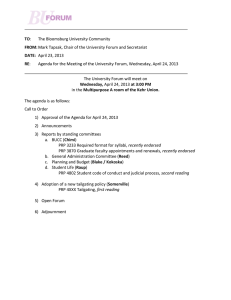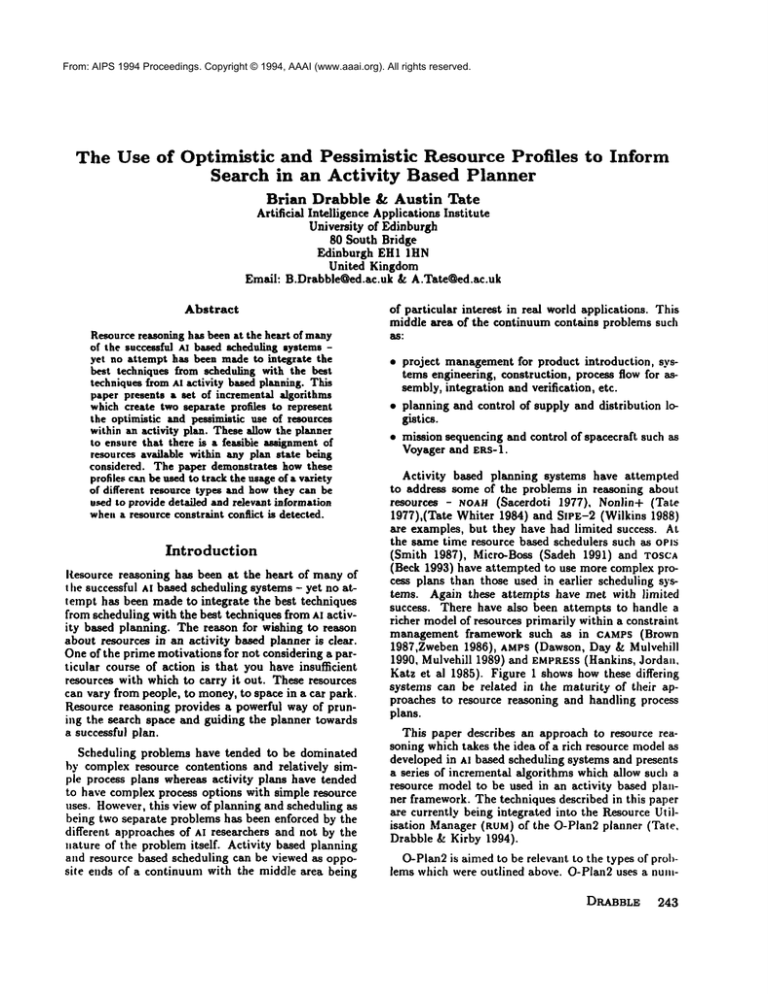
From: AIPS 1994 Proceedings. Copyright © 1994, AAAI (www.aaai.org). All rights reserved.
The Use of Optimistic
Search
and Pessimistic
Resource Profiles
in an Activity
Based Planner
Brian Drabble & Austin Tate
to Inform
Artificial Intelligence Applications Institute
University of Edinburgh
80 South Bridge
Edinburgh EH1 IHN
United Kingdom
Email: B.Drabble@ed.ac.uk & A.Tate@ed.ac.uk
Abstract
Resourcereasoninghas beenat the heart of many
of the successful AI based schedulingsystemsyet no attempt has been madeto integrate the
best techniques from scheduling with the best
techniquesfrom AI activity based planning. This
paperpresents a set of incremental algorithms
whichcreate two separate profiles to represent
the optimistic and pessimistic use of resources
within an activity plan. Theseallow the planner
to ensure that there is a feasible assignmentof
resources available within any plan state being
considered. The paper demonstrates howthese
profiles canbe usedto track the usageof a variety
of different resource types and howthey can be
,~d to provide detailed and relevant information
whet, a resourceconstraint conflict is detected.
Introduction
Resource reasoning has been at the heart of many of
t he successful At based scheduling systems - yet no attempt has been made to integrate the best techniques
from scheduling with the best techniques from xz activity based planning. The reason for wishing to reason
about resources in an activity based planner is clear.
One of the prime motivations for not considering a particular course of action is that you have insufficient
resources with which to carry it out. These resources
can vary from people, to money,to space in a car park.
Resource reasoning provides a powerful way of pruning the search space and guiding the planner towards
a successful plan.
Scheduling problems have tended to be dominated
by complex resource contentions and relatively simple process plans whereas activity plans have tended
to have complex process options with simple resource
uses. However,this view of planning and scheduling as
being two separate problems has been enforced by the
different approaches of AI researchers and not by the
nature of the problem itself. Activity based planning
a,d resource based scheduling can be viewed as opposite e,ds of a continuum with the middle area being
of particular interest in real world applications. This
middle area of the continuum contains problems such
as.
¯ project managementfor product introduction, systems engineering, construction, process flow for assembly, integration and verification, etc.
¯ planning and control of supply and distribution logistics.
¯ mission sequencing and control of spacecraft such as
Voyager and ERS-1.
Activity based planning systems have attempted
to address some of the problems in reasoning about
resources - NOAH
(Sacerdoti 1977), Nonlin+ (Tat.e
1977),(Tate Whiter 1984) and SIPE-2 (Wilkins 1988)
are examples, but they have had limited success. At
the same time resource based schedulers such as opts
(Smith 1987), Micro-Boss (Sadeh 1991) and TOSCA
(Beck 1993) have attempted to use more complex process plans than those used in earlier scheduling systems. Again these attempts have met with limited
success. There have also been attempts to handle a
richer modelof resources primarily within a constraint
management framework such as in cxMPS (Brown
1987,Zweben 1986), AMPS(Dawson, Day & Mulvehill
1990, Mulvehill 1989) and EMPRESS
(Hankins, Jorda,,
Katz et al 1985). Figure 1 shows how these differing
systems can be related in the maturity of their approaches to resource reasoning and handling process
plans.
This paper describes an approach to resource reasoning which takes the idea of a rich resource modelas
developed in A! based scheduling systems and presents
a series of incremental algorithms which allow such a
resource model to be used in an activity based pia,ner framework. The techniques described in this paper
are currently being integrated into the Resource Utilisation Manager(RUM)of the O-Plan2 planner (Tare,
Drabble & Kirby 1994).
O-Plan2is aimed to be relevant to the types of proSlems which were outlined above. O-Plan2 uses a nut,DRABBLE
243
From: AIPS 1994 Proceedings. Copyright © 1994, AAAI (www.aaai.org). All rightson
reserved.
the levels
Complex Process Options with
Simple Resources Uses
Task/Goal Expansion
Perspective
Nealm
SIPE
V
a
O-Plmz2
TOSCA
OPT
Resource Managmcnt
Perspective
Large Resource Contention Dominated
Problems with Simple Process Plans
Figure l: The Continuum of Planning and Scheduling
Systems
ber of Constraint Managers to maintain information
about a plan while it is being generated (Tate 1993).
The information can then be used to prune search
(whereplans are found to be invalid as a result of propagating the constraints managedby these managers) or
to order search alternatives according to someheuristic
priority’. Constraint Managersare intended to provide
efficient support to a higher level of the planner where
decisions are taken. They" do not take any decision
themselves. They are intended to provide complete information about the constraints they are managing or
to respond to questions being asked of them by the
decision makinglevel.
Management
Planner
in
an Activity
Resource constraint management within the O-Plan2
system is carried out by a Resource Utilisation Manager (RUM).It is the function of the RUMto check
244
POSTERS
1. Set a resource level to he a particular value (or
within a particular range) For example, top up
fuel tank to its maximum
capacity.
2. Allocate a certain amount of resource i.e. reduce
the amount of resource remaining as available from
that point within the plan. Semantically, an allocation must be paired with a subsequent deallocation.
Deallocate a certain amountof resource back to the
.
resource pool, i.e. increase the amountof resource
available from that point in the plan.
4. Consumea certain amount of resource.
5. Produce a certain amount of "new" resource.
The initial declaration of resource types (e.g. fuel,
food, money, plumbers, etc.) is accomplished by using a reaoarce_type definition in the O-Plan2 domain
description language (Task Formalism- TF), together
with the information required to define that resource.
For example,
OPIS
Resource
of resources being used at certain points
in the plan. The RUMis informed of resources level
changes in a plan by means of Resource Utilisation
Entries (KUE’s). A RUE Can change resource levels in
one of five different ways:
types
fuel’loc --- (portl port2 port3 shipl),
fuel’storage
= (tankl tank2 tank3 tank4 tankS),
prov’type = (frozen chilled fresh),
prov’loc = (portl port2 ports port4).
prov’storage
= (warehousel warehouse2 warehouae3),
resource" types
consumable’producible’by’agent
-resource fuel ?-type fuel’loc"
~-type fuel’storage’’
= gallons,
eonsum ablelproducible’by’
agent
-resource provisions ?-type prov’type"
?-type prov’loc"
?-type prov’storage’" ---- kiloa;
The actual usage and setting of resource levels in
the plan is achieved by RUg’swhich are derived from
resource statements in TF action schemas. These provide changes to resources levels i.e. increments (produces, deallocates),
decrements (consumes, allocates) and sets.
The RUMmaintains resource usage profiles that reflect the changes of resource levels indicated by the
RUGS.There can be uncertainty in two dimensions: in
the actual level of resource changes and in the time
at which such a change occurs. The RUtSmanages resource usage profiles in order to provide the following
functionality for the planner:
¯ Adding a new resource utilisation
into a resource profile
As actions are expanded in the plan new resource
utilisations will needto be addedto the resource profile. The RUM
will need to constrain the resources
affected and monitor for resource violations.
From: AIPS 1994 Proceedings. Copyright © 1994, AAAI (www.aaai.org). All rights reserved.
¯ Modifying an existing resource utilisation
entry
Existing resource entries will be modified during the
plan as their time and resource windows are constrained by other activities.
The RUMwill propagate the effects of these changes through only those
resource entries affected.
¯ Providing feedback when a constraint
violation occurs
The RUM
is able to provide specific advice relevant to
the particular problem which has arisen. By using
the type of a resource to restrict the options proposed, the RUMcan suggest altering the resource
levels in other related resource entries and/or modifying the time constraint of related resource entries.
Management of Resource Specification
and Aggregate Resource Usage
Resource information in O-Plan2 action schemas is
used to to restrict search and to ensure that resource
usage in a plan stays within the bounds indicated.
There are two types of resource statements. One gives
a specification of the overall limitation on resource usage for a schema(over the total time that the schema’s
expansion can span). The other type of statement describes actual resource utilisation at points in the expansion of a schema. It must be possible (within the
flexibility admitted by the actual resource utilisation
statements) for a point in the range of the aggregate
of the resource utilisation statements to be within the
overall resource specification given.
1. the specification of the limits on resources used
within a schemaand all its possible expansions. For
example, a schema to move a ship from one port to
another may specify that it may consume between
100 and 1000 gallons of fuel depending on which ship
and whichpair of a specified set of ports is chosen.
resource consumes (resource fuel) ----
I00:I000 gallons overall;
2. the utilisation of resources on a particular action
or at a particular time point within a schema. In
this exampleshipl receives 5000gallons of fuel into
itssingle
fueltankattheendofaction
5 fromtankl
at portl.
resourceproduces
(resource
fuelship1tankl)ffi 5000gallons
at end’ofnode-5,
consumes (resource fuel portl tankl) ---- 5000 gallons
at end’of node-5;
All resource specifications and utilisations are maintained as rain/max pairs, specifying the upper and
lower bounds known at the time. Resource declarations which describe resource specifications and utilisation statements (perhaps still only partially specified) are held in the plan being developed by O-Plan2.
The current best numerical bounds on resource utilisation statements are also converted to RVZ’swhich are
stored in a Resource Utilisation Table (aVT) with (notionally) one table per specific resource available. The
entries of the RUTare held in ascending time point order. The following table (Table 1) is a fragment from
a RUTfor a specific fuel tank tl which is at port pl
and contains fuel fl.
The entries, within the RUTare fully qualified entries
and as such represent actual resource utilisation. A
schema which states that it produces 500 gallons of
fuel from portl is viewedas a specification as the actual
change in a resource cannot be specified relative to a
port - but only for a specific fuel tank at a location (a
port or a ship).
Optimistic and Pessimistic Resource
Profile Management
The algorithm used to track resource levels uses two
distinct measures:
1. Optimistic Resource Profile (ORP)
This describes the maximum
resource that could be
available with optimistic assumptions and is calculated from:
(a) the set resource statements
(b) the minimal resource usage at the maximumtime
value of a time point for an RUEwith negative
influences, i.e. allocates, consumes.
(c) the maximal resource usage at the minimumtime
value of a time point of an RUEwith positive influences, i.e. deallocates, produces.
For example, if action 1 allocates between 20 and
30 resource units between time 4 and time 8 then
the ORPnormally decreases by 20 at time 8 (unless
a set is given at the same time point).
2. Pessimistic Resource Profile (PRP)
This describes the minimumresource that would be
available with pessimistic assumptions and is calculated from:
(a) the set resource statements
(b) the maximal resource usage at the minimumtime
value of a time point of an RUEwith negative influences, i.e. allocates, consumes.
~source
No
I
.’2
3
4
÷
(resource
(resource
(resource
~resource
fl
fl
fl
fl
pl
pl
pl
pl
tlJ
tl)
tl}
tl)
quantity
20:20
20:30
15:15
10:15
Time Point
tpl
tp2
tpl9
¢p36
Min
0
4
6
7
TableI: Example
Resource
Utilizv.t-~cn
T~’~’o
DRABBLE
245
From: AIPS 1994 Proceedings. Copyright © 1994, AAAI (www.aaai.org). All rights reserved.
1,’) the minimal resource usage at the maximumtime
value of a time point of an Rug with positive influences, i.e. deallocates, produces.
For the above oRP example, the PRP normally decreases by 30 units at time 4 (again unless a set is
given)
By calculating the changes in anticipated resource
levels at specified points along a time line, a profile
can be generated for the Ogr and the rgP. Using the
first three entries of the RUTdescribed in Table 1, the
following graph (Figure 2) of resource levels against
time can be generated.
40
3O
20
10
0
-IC
-2C.
-30
-4C
to
Maintain
PRP and ORP
base valt~
for PRP and ogP and the ORP and PRP
themselves can be calculated for any time point using
the following formulae:
The
I
ORP
. .........PRP
4 ....
FORMULA I - PESSIMISTIC
~ 8
10
To generate the profile the RUM
needs to keep track
of various pieces of information and to be sensitive to
tile type of change which is being carried out for each
RrE in the RUT. The changes which the RUMmust
deal with are the addition of a new Rug or the modification of an existing RUE.The information which is
maintained is as follows:
1. Optimistic Increment (Optlnc) which is defined
the incremental change in the level of resource at a
particular time point ignoring sets. It is calculated
from summing:
(a) If the time point in question is the maximum
time
point of an allocates or consumes then add in
the minimumchange in resource for each record
(b) If the time point in question is the minimumtime
point of a dealloeates or produces then add in
tile maximum
change in resource for each record.
2. Pessimistic Increment (PesInc) which is defined
the incremental change in the level of resource at
a time point ignoring sets. It is calculated from
sutural,g:
time
(a) If the time point in question is the maximum
point of a deallocates or produces then add in
the minimumchange in resource for each record
POSTERS
5. Whethera set is involved as one of the RUE’sat the
time point.
6. Dependencyrecords containing lists of RUg’s affected by resource information at time point.
Formulae
Figure 2: Optimistic and Pessimistic Profiles of Re.~ource Utilisation
246
(b) If the time point in question is the minimumtime
point of an allocates or consumes then add in
the maximum
change in resource for each record.
3. A base value of PRPto assist in incrementally computing the actual PRP.
4. A base value of ORPto assist in incrementally computing the actual ORP.
PROFILE:
IF one or more act entries awe present THEN
IF there are over lapping sets THEN
PRP = minimum of all overlapping
sets
ELSE
IF there are overlnpping daallocates or produces then
bue’PRP = baae’PRP 4" the maximumresource value for all
overlapping deallocate
or produce HOE’s
ELSE
baae’PRP = minimum of the minimum of the set value
ENDIF
ENDIF
PRP ffi baac’PRP
ELSE
bese’PRP = PRP at a prevmus time point in the RUT or
0 d none avmlable
PRP = base’PRP + Peslnc
ENDIF
FORMULA 2 - OPTIMISTIC
PROFILE:
IF one or more set entries
~ present THEN
IF there are overlapping sets THEN
ORP : max,mum of all overlapping
sets
ELSE
IF there are overlapping allocates or consumes then
base’ORP = bsse’ORP + the max,mum
resource value for all overlapping
allocate or consume RUE’s
ELSE
base’ORP = maximum of the maximum set value
ENDIF
ENDIF
ORP = base’ORP
ELSE
base’ORP = ORP at a prevmus time point in the RL’,T or
0 ,f none available
ORP = base DRP + Optlnc
ENDIF
Example
Involved
when a Resource
"Set"
is
The above formulae will now be demonstrated on an
example in which there are positive or negative resource changes which may occur within the time range
of a set (e.g. see Figure 3).
From: AIPS 1994 Proceedings. Copyright © 1994, AAAI (www.aaai.org). All rights reserved.
(dealk~ate 4::6,)
t=9
t=4
t--’7 (set 5::12) t--~13
t_--45 (set 4::10) t=ll
t=’2 (allocate 4::6) t=8
Figure 3: Set Spanning a Resource Change
in this example the allocazion of the resource
will take place some time between t=2 mad if8 and
will allocate between 4 and 6 units. However, there
are two sets which may occur in parallel with this
allocation.
This is further complicated for illustrative purposes in this example by including a
deallocate. By using the algorithms described above
it is possible for the mUM
to construct the PRPand 01tP
profiles and to find that there is at least somepossible
allocation of resources whichis valid.
Detection
of Resource
Failures
Utilisation
The failure of the addition of a RUgor during propagaI ion of RUEentries represents an attempt by the plan
!o use moreof the resource than there is available. The
failures types which have been identified so far are as
follows:
1. ORPless than ZEROThis failure means the even
with that most optimistic assumptions there is insufficient resource available.
2. ORP less than PEP This failure
means the
resource utilisation has been declared incorrectly
within the domaindescription (TF) definitions.
The gUMinforms the planner of the RUEwhich has
a fault and the possible tactics available to resolve the
conflict, These are as follows:
1. increase the earliest start time of a failing action i.e,
start it later.
2. alter the lastest finish or earliest start time of possible actions which contribute to the problem. This
wilt dependon whether the actions are taking or giving back a resource. It maymake more sense to give
some resource back earlier or take a resource later
(if time constraints allows) rather than reduce your
ownresource utilisation.
3. increase the maximum
resource level available at a
point b.v adding a set of a particular resource. For
example, if the authority can be found an extra shift
of workers or an extension to the working day may
resolve the resource problem.
The actual tactics proposed are sensitive to the reiamrce type for the RUEinvolved.
Summary
This paper has described a mechanismfor the incremental managementof optimistic and pessimistic re.
source usage profiles in an activity planning framework. A rich resource model can be handled which
can manageuncertainty in the time at which resources
are used and the absolute resource levels involved in
any resource level change.
The technique allows for an AI planner to check the
feasibility of resource availability for plans being considered in the search for a solution. The techniques
allows for the maintenance of resource usage profiles
within which a specific resource allocation should he
possible.
Acknowledgements
Current O-Plan2 work is supported by the us Advanced Research Projects Agency (ARPA) and the US
Air Force RomeLaboratory acting through the Air
Force Office of Scientific Research (aFSC) under contract F49620-92-C-0042.The project is monitored by
Dr. Northrup Fowler III at the USAFRomeLaboratory.
The United States Governmentis authorised to reproduce and distribute reprints for governmentpurposes
notwithstanding any copyright notation hereon.
All views expressed are those of the authors only.
The information contained in the paper has benefited from discussions with manytalented researchers
who have worked on the O-Plan and related projects.
Thanks are due for productive discussions to our coworkers on the O-Plan2 project: Jeff Dalton and Glen
Reece.
References
Beck, H. 1993, TOSCA: A Novel Approach to the
Managemento/Job-shop Scheduling Constraints, lu
Realising CIM’sIndustrial Potential: Proceedings of
the Ninth CIM-Europe Annual Conference, Amsterdam, 12-14 May 1993, (eds, C. Kooij and P.A. MacConaill and J. Bastos), pp138-149.
Brown, R. 1987, Knowledge-based Scheduling and
Resource Ailocatzon in the CAMPS
Architecture, in
Proceedings from the International Conference on
expert Systems and the Leading Edge in Production Planning and Control (ed.. M. Olitf.), Benjamin/Cummings, Menlo Park, CA 1987.
Dawson, B., Day, D.S. and Mulvehill, A. I990, The
AMPS Final Report, Final Report, USAF Rome
Laboratory Technical Report RADC-TR-90-131.July
1990.
DRABBLE 247
From: AIPS 1994 Proceedings. Copyright © 1994, AAAI (www.aaai.org). All rights reserved.
llnnkins, G.B., Jordan, J.W., Katz, J.L., Mulvehill,
A..%I., Dumoulin, J.N. and Ragusa, J. 1985, EMPRESS: Ezpert Mission Planning and REplanning
.~’ckrdul, ng System, in Expert Systems in Government
.~ymposium, 1985.
.’dulvehill,
A. 1989, CAMPS/AMPS
FY88 Year End
Report, The MITRECorporation, Technical Report
.%!89-28, May1989.
Sacerdoti, E. 1977, A Structure for Plans and Bekav, omrs, Artificial Intelligence Series, North Holland,
1977.
Sadeh, N. 1991, Look-ahead Techniques for Microopportunistic Job Shop Scheduling, Ph.D., CMU-CS9 [- ! 02, School of ComputerScience, Carnegie Mellon
University, 1991,
Smith, S.F. 1987, A Constraint-Based Frameworkfor
Reactive Managementof Factory Schedules, In Proceedings International Conference of Expert Systems
and the Leading Edge in Production Planning and
C<>ntrol, Charleston, South Carolina, May, 1987
Tate, A. 1977 Generating Project Networks, In Proceedings of the International Joint Conference on
Artificial Intelligence (IJCAI-77), Cambridge,Mass.,
USA, 1977.
"late, A. 1993, The Emergence of "Standard" Planning and Scheduling System Components, In Proceedings of the Second European Workshop on Planning
(EWSP-93), lOS Press, Sweden, 1993.
Tare. A., Drabble, B. and Kirby, R. 1994, O-Plan2:
An Open Architecture for Command, Piannzng and
Control, in Intelligent Scheduling (Eds. M. Fox and
M. Zwehen), Morgan Kaufmann, 1994.
Tate, A. & Whiter, A. 1984, Planning with Multiple
Resource Constraints and an Application to a Naval
Planning Problem, in Proceedings of the First Conference on Artificial Intelligence Applications, pp. 410416, AAAI, Denver, Colorado, USA, December 1984.
Zweben, M. 1986, CAMPS: A Dynamic Replanning
System, The MZTRECorporation, Technical Report
M87-50, December 1986.
Wilkins, D. 1988, Practical Planning, Morgan Kaufmann, 1988.
248
POSTERS


